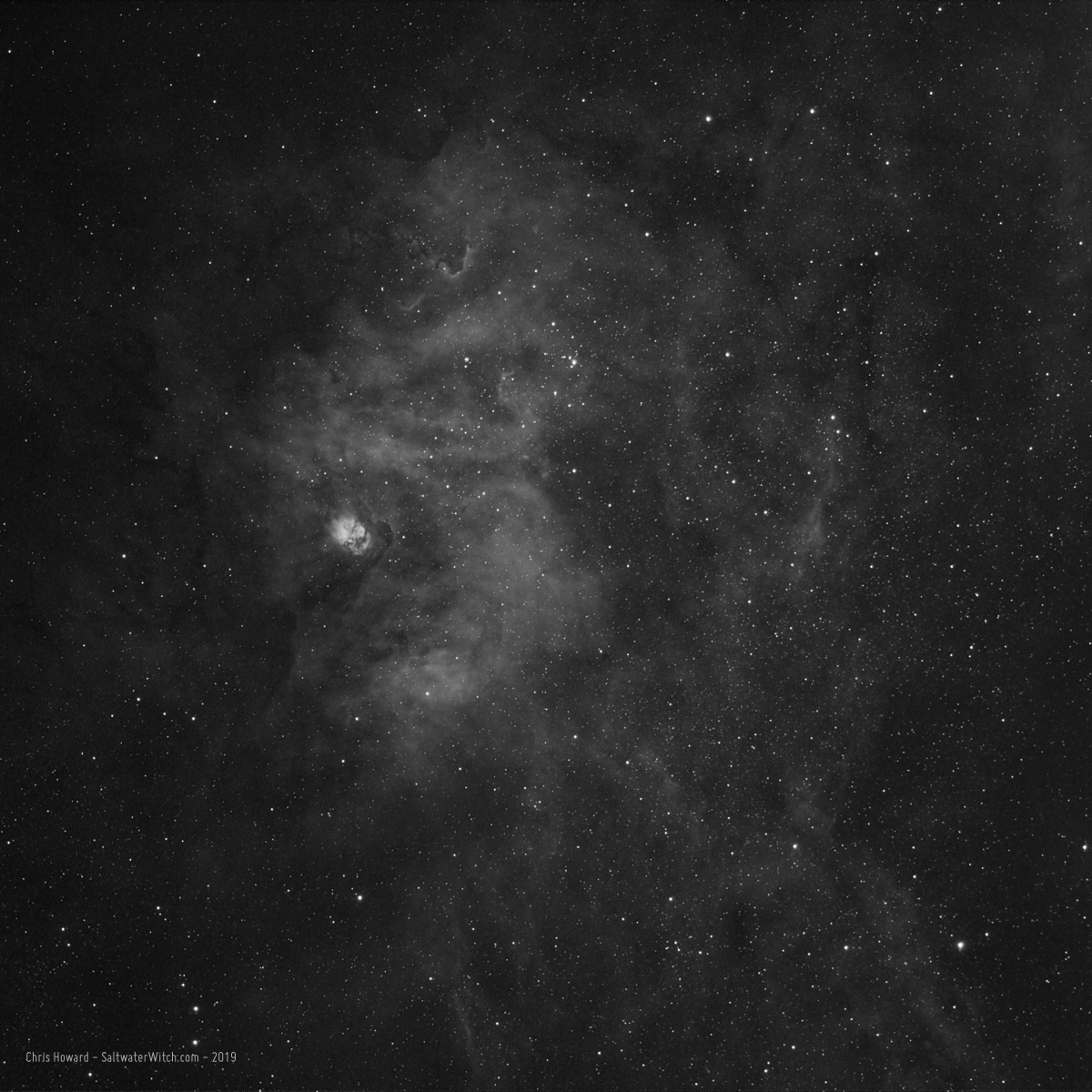NGC 1499 (California Nebula) Reprocess
While the clouds and rain hang about, I'm reprocessing some data from late last year. False color imaging is fascinating, and I'm retrying the bi-color, Hydrogen-alpha and Sulfur 2 made up of Red and Blue with equal parts Green. The dark clouds of interstellar dust and pockets of hydrogen stand out more this time. NGC1499 is an emission nebula in the constellation Perseus, about 1000 lightyears away from us. This is the central region of the California Nebula, so that means the interstellar version of Fresno is somewhere in there. 
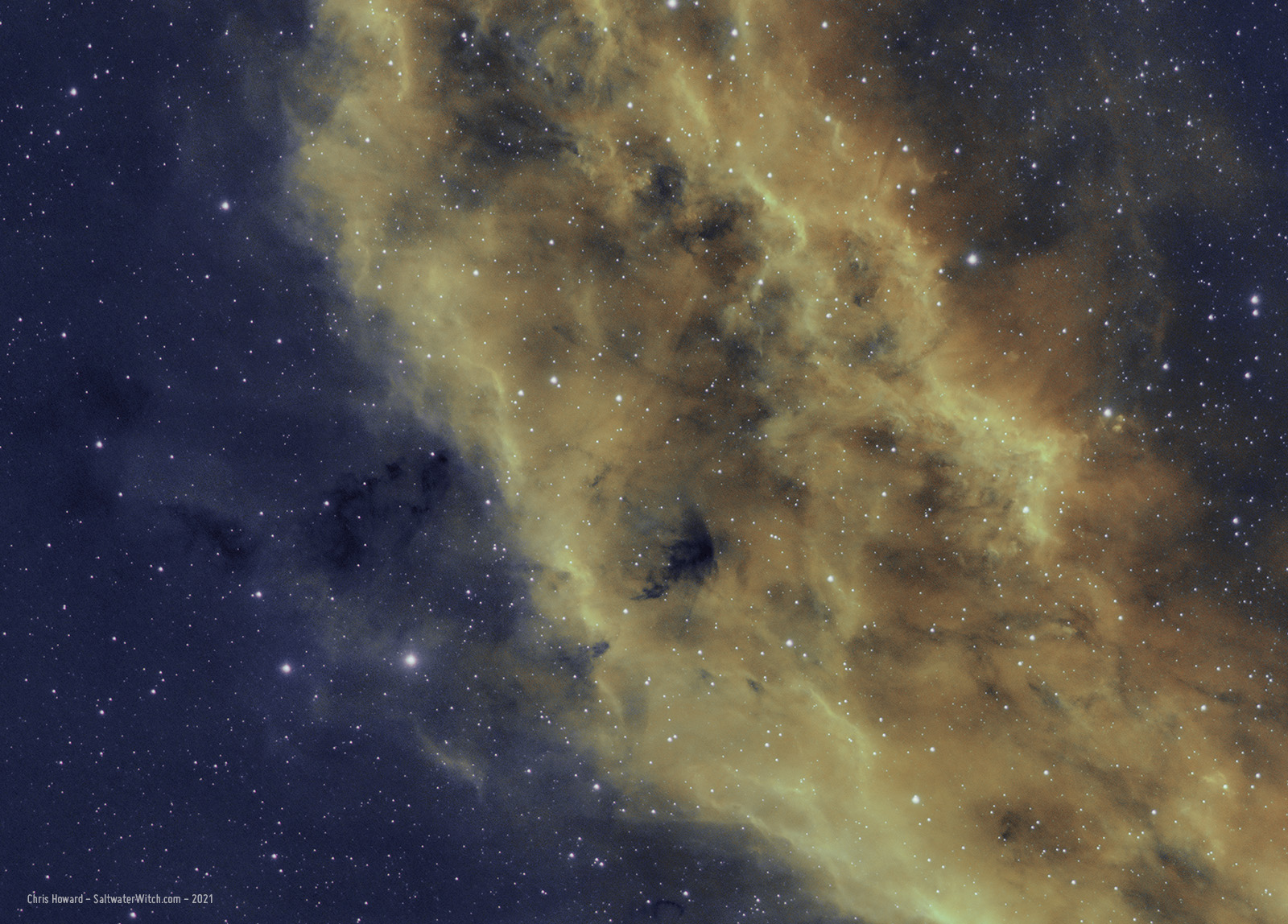
Posted May 23, 2021
So, How's the New Backyard Pier Going?
 That's the big question. Over the last couple weeks I have had five clear nights of imaging with the new pier—the pier allows me to keep my astro gear setup semi-permanently. I park the scope at the end of the night, shut everything down, throw the cover over it and cinch it up. Done. (I bought a TeleGizmos 365 Series Cover for 8-10" SCT from OPT several months back, but I'm just starting to use it now). There were three rainy days between these image captures, and a couple nights that dipped below zero (low 20°s F/ -6C). I left the mount and scope set up in the rain, protected by the cover, and with a couple bags of desiccant, the equipment was completely dry. Unlike a tripod, the pier allows me to tighten the cover around the post under all the equipment, holding off any moisture that might rise up from wet grass and ground.
That's the big question. Over the last couple weeks I have had five clear nights of imaging with the new pier—the pier allows me to keep my astro gear setup semi-permanently. I park the scope at the end of the night, shut everything down, throw the cover over it and cinch it up. Done. (I bought a TeleGizmos 365 Series Cover for 8-10" SCT from OPT several months back, but I'm just starting to use it now). There were three rainy days between these image captures, and a couple nights that dipped below zero (low 20°s F/ -6C). I left the mount and scope set up in the rain, protected by the cover, and with a couple bags of desiccant, the equipment was completely dry. Unlike a tripod, the pier allows me to tighten the cover around the post under all the equipment, holding off any moisture that might rise up from wet grass and ground.
So, how's the pier functioning? Perfectly. My goal was to be able to setup my gear and leave it outside for long periods—maybe weeks, and not have to polar align after the first night. I did run through a polar align the second night because I wanted to see how well it maintained alignment, and it was right on. I have now gone through three more imaging sessions without polar aligning! I simply check the weather, pull off the cover, power up everything, and begin my first sequence of the night. It really has been that simple.
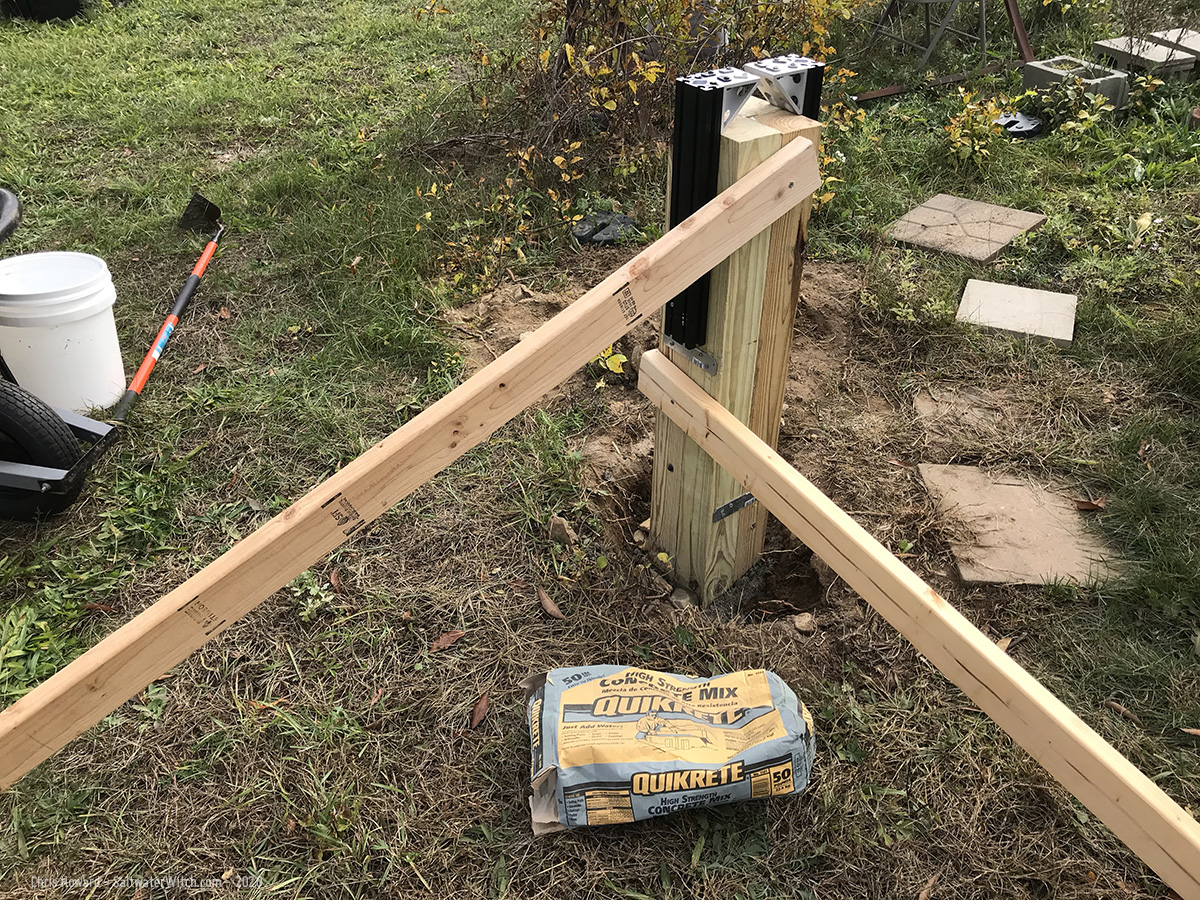 How is the Total RMS when guiding? Very good—what I expected. Depending on seeing and other factors I've been running with .5" to right around 1", which is as good as it gets for my skies and mount. The pier is rock solid. We'll see how four bolted together lengths of treated lumber behave over time, but I am not expecting any movement.
How is the Total RMS when guiding? Very good—what I expected. Depending on seeing and other factors I've been running with .5" to right around 1", which is as good as it gets for my skies and mount. The pier is rock solid. We'll see how four bolted together lengths of treated lumber behave over time, but I am not expecting any movement.
The distance from the reducer/flattener to the sensor is just a hair too far, maybe a millimeter off, so stars are slightly wonky. I'm still playing around with a few equipment details. Other than that, I'm really happy with these imaging runs. Start-up and shut down is so easy. This really is the next best thing to a backyard observatory. And building the walls and roll-off roof of a tiny observatory around the pier might be a next step, who knows? I also have my micro-observatory project still underway, but that only works with a small mount. I'm having an issue right now with the CEM25P, and I have to resolve that before I can get back to the micro project. At the end of the day, what's cooler than having a permanent astro setup in the backyard? Yup, two permanent astro setups in the backyard.
I went with Hydrogen-alpha for last night's run, and targets included with 60 x 240sec subs of IC 405 (Flaming Star Nebula) in Auriga, and 60 x 240sec subs of IC 2177 and NGC 2327 (Seagull Nebula) in Canis Major.
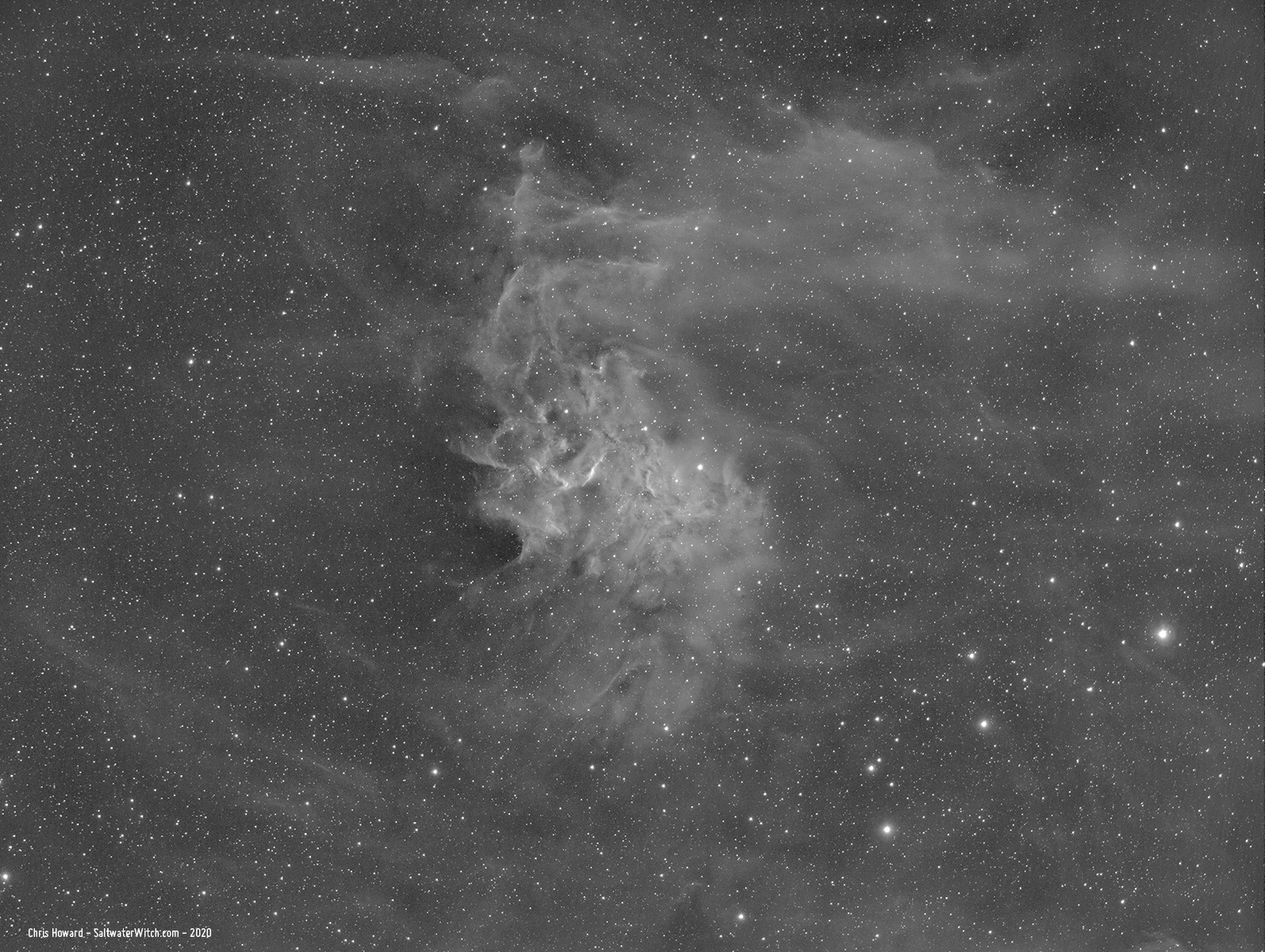
IC 2177, NGC 2327—Seagull Nebula:
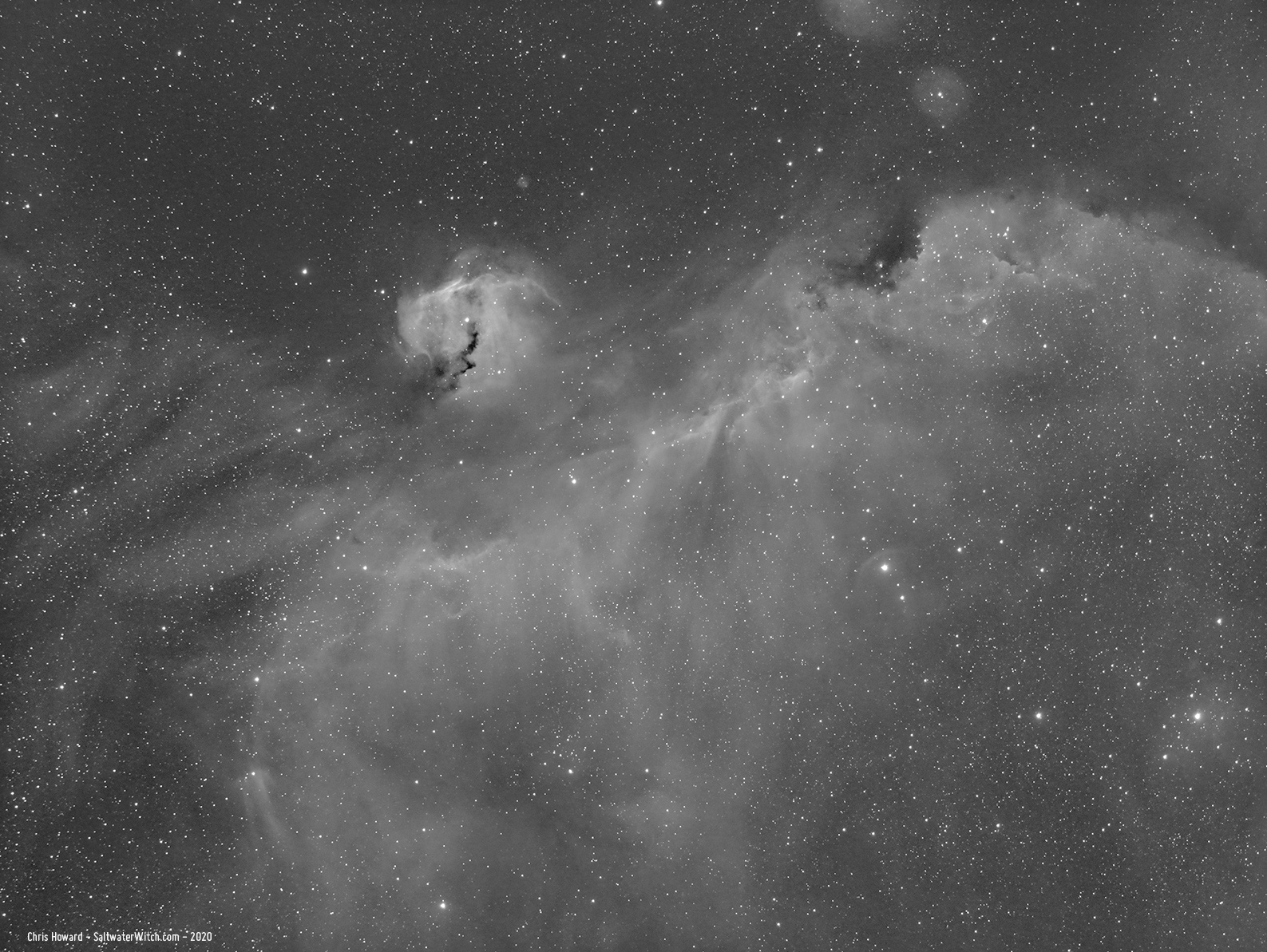
Gear notes: SkyWatcher EQ6-R Pro mount, William Optics GT81 Apochromatic Refractor 392mm at f/4.7, ZWO ASI1600MM-Pro monochrome camera, Astronomik 6nm filters, Moonlite focuser, Raspberry Pi 4 4GB / 128GB running INDI/KStars/Ekos
Posted November 19, 2020
The Orion Nebula in Hydrogen-alpha
I have to capture M42, M43, NGC 1977, the Orion, De Mairan's, and Running Man Nebulae at least once a year, and now through December is when the Constellation is high in the sky and still early enough be awake--I captured most of the 52 subs that went into this shot between 11:30 and 2am. This is just one filter's worth. I have to go back and either take OIII and SII or Blue and Green, using this Ha capture for the Red channel in RGB.
Imaging session notes: 52 x 240 second subs + 50 x 10 second subs for the Trapezium, stacked in DSS, processed in PS 2021. SkyWatcher EQ6-R Pro mount, William Optics GT81 Apochromatic Refractor 392mm at f/4.7, ZWO ASI1600MM-Pro monochrome camera, Astronomik 6nm Ha filter, Controller: Raspberry Pi 4 4GB / 128GB running INDI/KStars/Ekos.
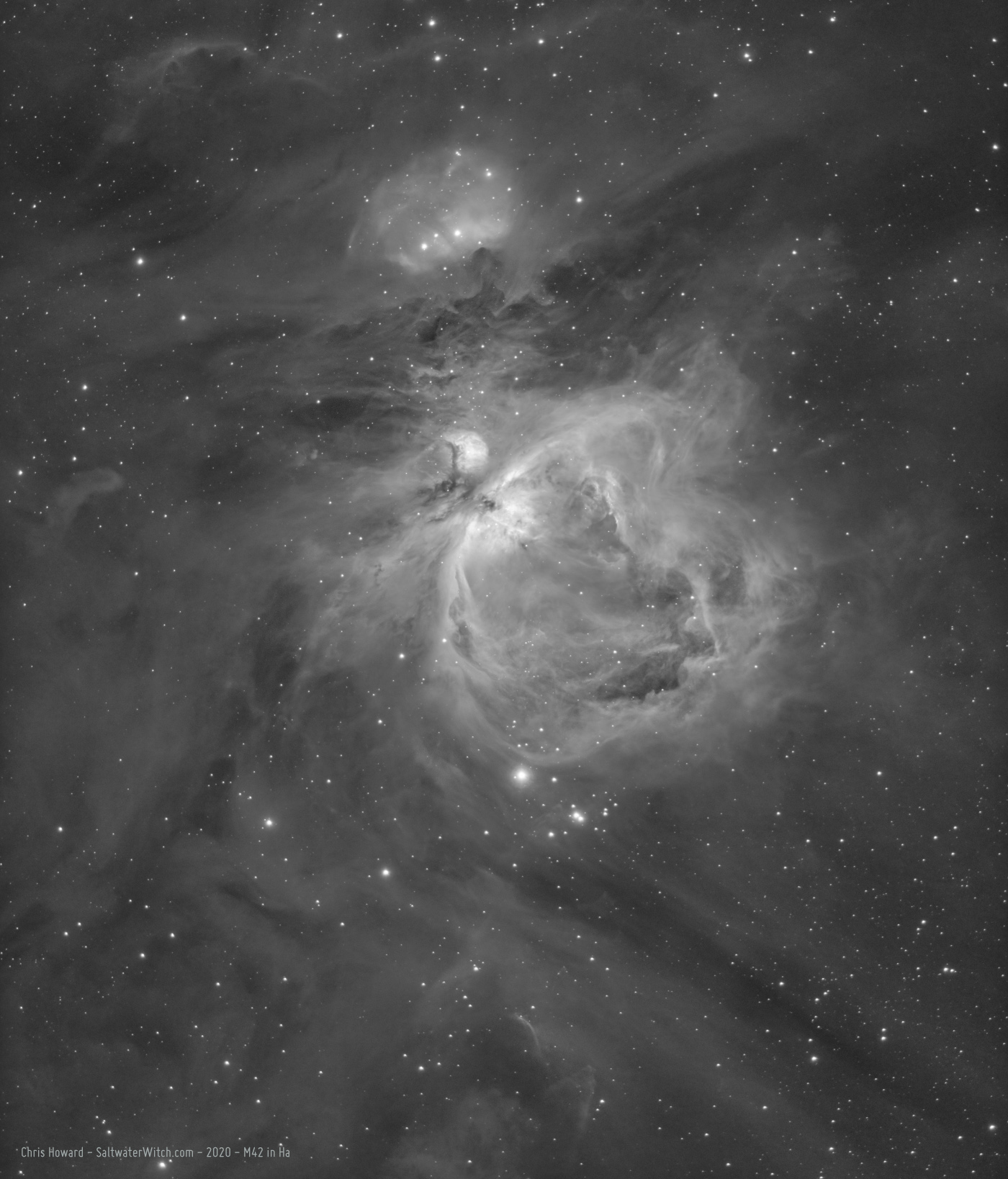
Posted November 10, 2020
California Nebula in Hydrogen-alpha
The California Nebula (NGC 1499) in the Constellation Perseus is relatively close to us, about 1000 lightyears away in the Orion Arm of our galaxy (Milky Way), and it's roughly a 100 lightyears in length, so what you see here, top to bottom, is about 600 trillion miles of ionized hydrogen. NGC 1499 is a good-sized emission nebula, about 2.5° in length from our view on Earth. To put that into perspective, a full moon is 1/2°, so the California Nebula is about 5 full moons long in the sky.
Imaging session notes: 50 x 240 second subs, stacked in DSS, processed in PS 2021. SkyWatcher EQ6-R Pro mount, William Optics GT81 Apochromatic Refractor 392mm at f/4.7, ZWO ASI1600MM-Pro monochrome camera, Astronomik 6nm Ha filter, Controller: Raspberry Pi 4 4GB / 128GB running INDI/KStars/Ekos.

Posted November 10, 2020
The Wizard
The Wizard Nebula in Cepheus surrounds the star cluster, NGC7380, discovered by Caroline Herschel in 1787. The Wizard is between 7000 and 8000 lightyears away from us, and the core star forming region is about 100 lightyears across. Notes: Shot from my backyard with a William Optics GT81, iOptron CEM25P EQ mount, Moonlite Focuser, ZWO ASI1600MM-Pro Monochrome Camera, Astronomik 6nm narrowband filters.

Posted April 25, 2020
The Wizard and the Soul
I captured almost 5.5 hours of OIII and SII data on NGC 7380 (Sh2-142) the Wizard Nebula and star cluster in Cepheus, along with a full set of narrowband frames for IC 1848 the Soul Nebula in Cassiopeia. I timed things well enough that I captured 20 subs each of Ha, OIII, and SII for the Soul before the earth rotated into early morning. Not a ton of data, but enough to process and see how it looks--not bad, in my opinion. My camera rotation is almost 90º off, almost vertical against the long side of the sensor, but I cropped the nebula to a square so you don't have to see how silly that looks.
I captured the Ha data for the Wizard Nebula early in July, and now I have enough to process in SHO (Hubble Palette) that's where we map the three bandpasses, sulfur (SII), hydrogen (Ha), and oxygen (OIII) to RGB, Red, Green, Blue to make up a color image.
Here's NGC 7380, Sharpless 2-142, Wizard Nebula:
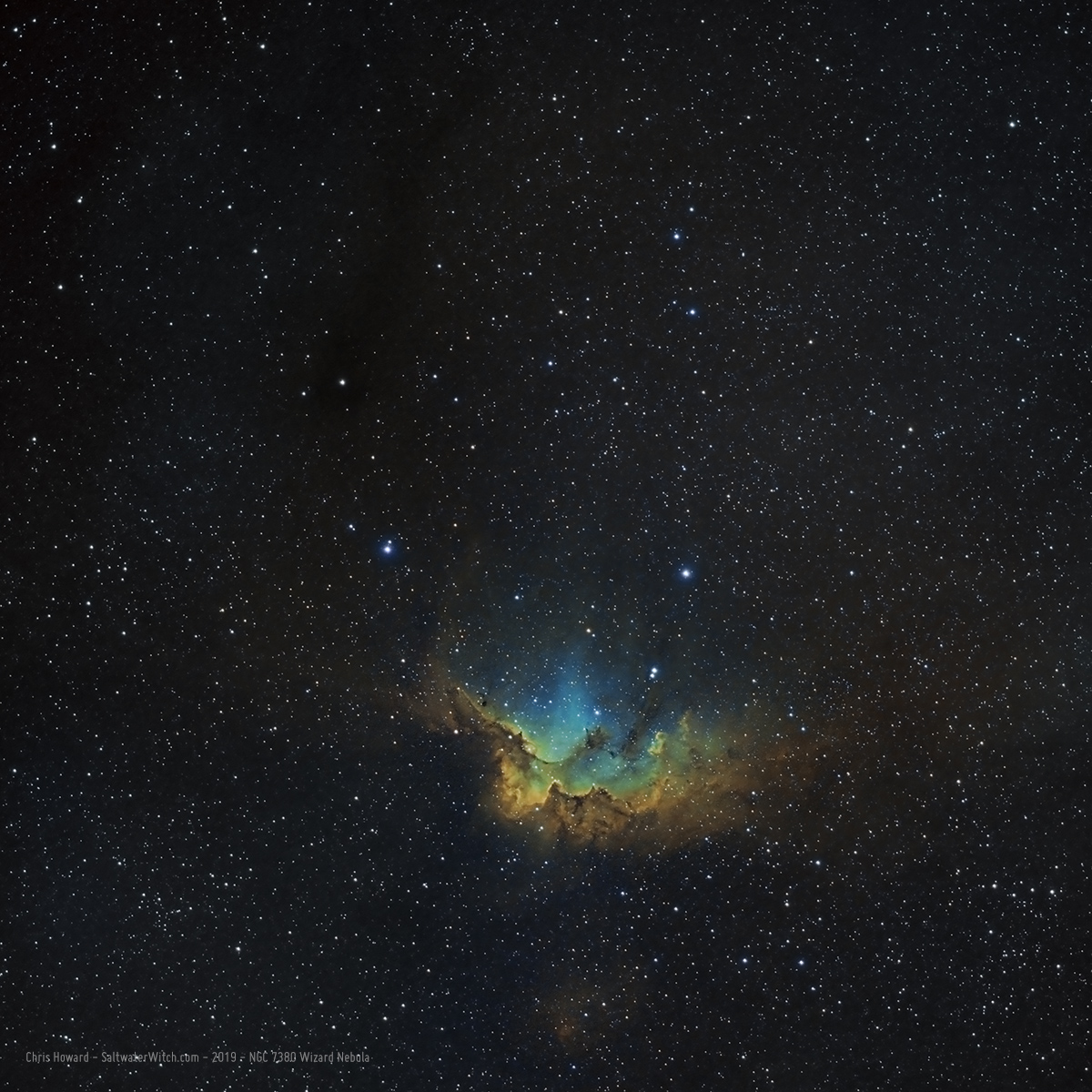
IC 1848, the Soul Nebula:
I don't know if I succeeded but I was trying to get more hydrogen green back into the arrangement. Most of the nebula is hydrogen--just going off the signal in the Ha frames compared with the OIII and SII data. The rims of both regions of IC 1848 are thick with sulfur--red and green gets us that golden brown, but I think the processes, filters, actions typical for astro imaging go too far in reducing green in the images, bending it more toward blue. This does have the benefit of bringing out oxygen, which is nowhere near as plentiful as the blues I see in most SHO/Hubble Palette images. That's just what everyone's come to expect from a "Hubble" image. On the other hand this is one of the coolest aspects of the hobby, the ability to go back and re-processes your data, because you have new or improved processing tools or skills, a new set of data, or simply because you want to experiment with color allocation.
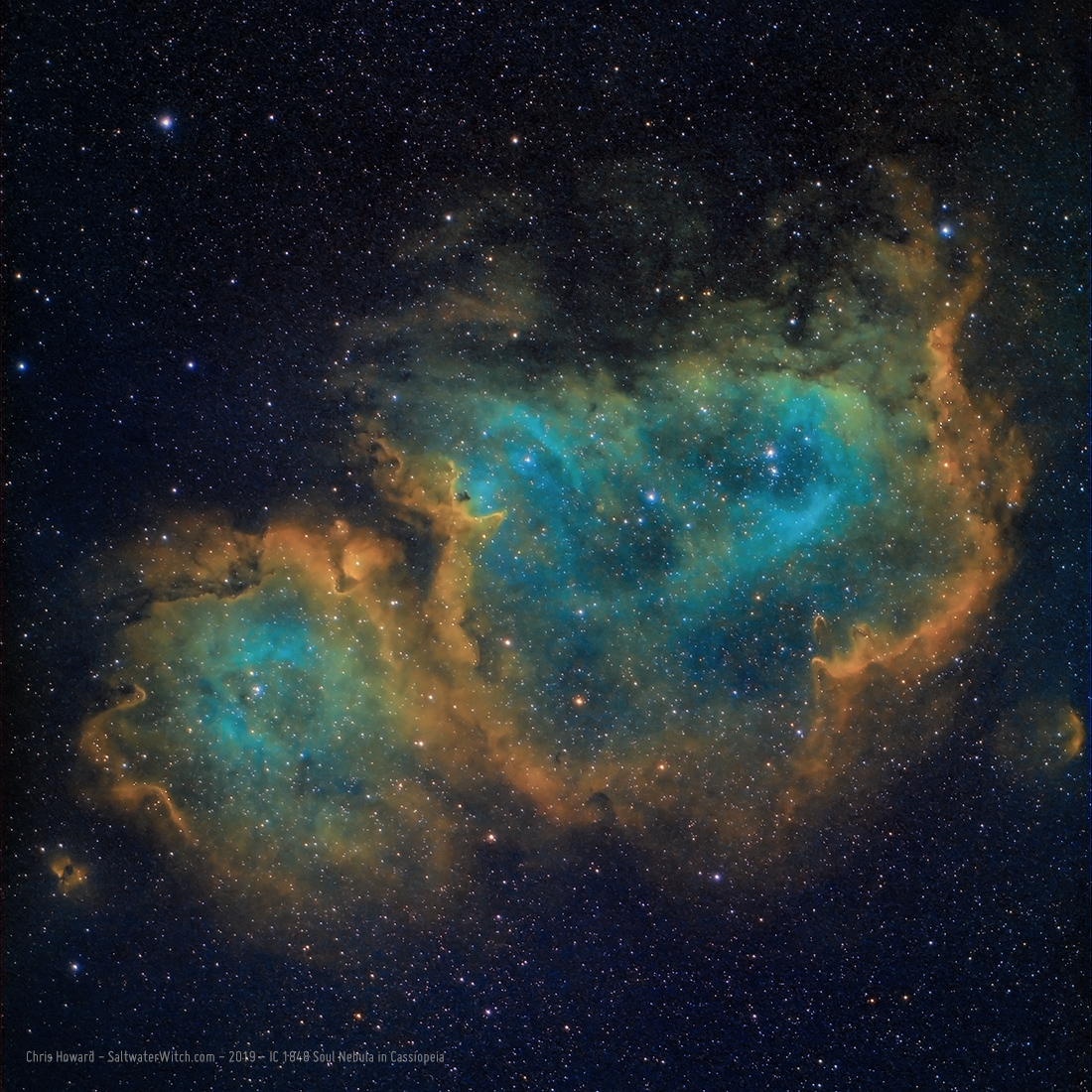
I woke up around 3:30 am and went out to check on the night's imaging run. I was in the middle of the sulfur2 frames when I took this shot with the Nikon: the William Optics GT81 APO refractor pointed at Cassiopeia (top left), actually just below it, which is where you will find IC 1848, the Soul Nebula. Just so you are aware, this is all automated--slewing, plate solving, focusing, filter rotation, and image capture. Once I plot and schedule an imaging run, the last place I want to be is near the telescope where the slightest motion in the ground can ruin a good 5-minute exposure. I was just out there to look at the beautiful sky, and take some crappy blurry photos of my astro gear against the starry background.
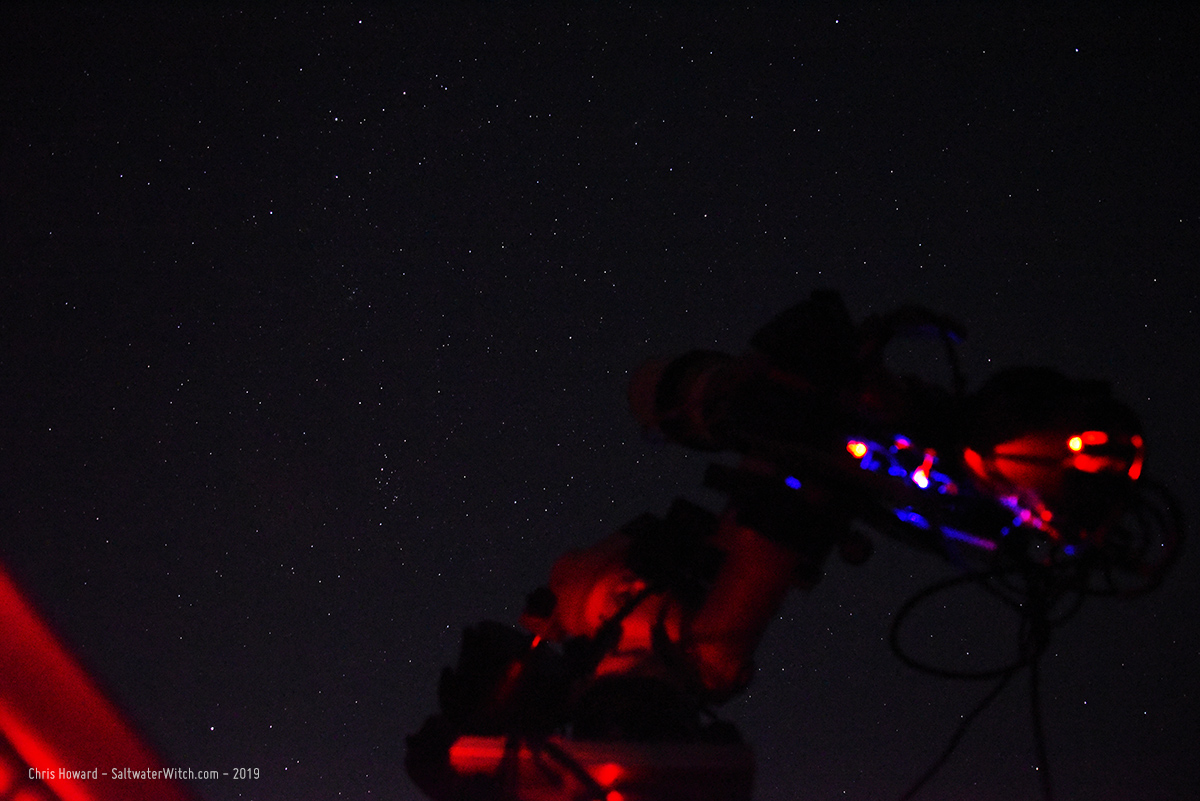
Posted August 2, 2019
Pelican Nebula ( IC 5070 and IC 5067)
Another one from my June 8th narrowband imaging run through the constellation Cygnus. The Pelican Nebula ( IC 5070 and IC 5067) in sulfur 2, hydrogen-alpha, oxygen 3, mapped to RGB.

My narrowband imaging rig: William Optics GT81 (81mm aperture, focal length 392mm, f/4.7), Moonlite Focuser, Pegasus Astro Power, and ZWO monochrome cameras and EFW.
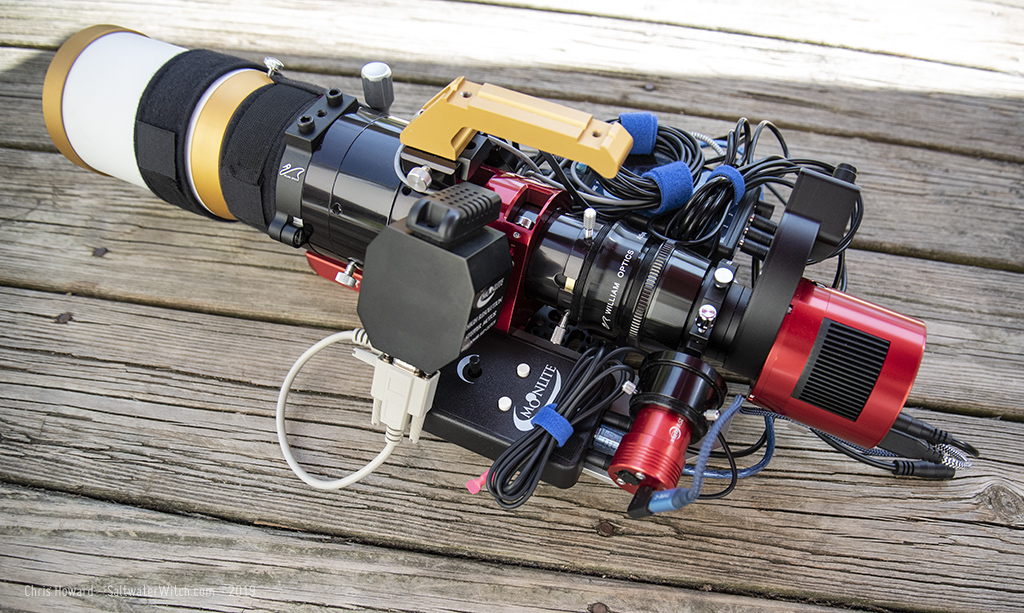
Posted July 25, 2019
Short nights, narrow bands, works in progress
We probably have less than four hours of seriously dark night this time of year--at my location, coastal New Hampshire. And you have to make do with that. So, last night I spent every minute on hydrogen-alpha frames for three targets, Sh 2-54 (with the star cluster NGC 6604 in the center), NGC 7830 Wizard Nebula, and NGC 281 Pacman Nebula. I went through each of these and shot 30 x 180 second exposures, starting around 10:30 pm, which is still a bit within astronomical twilight.
The nebula Sh2-54 is about 5000 lightyears away in the constellation Serpens. It's part of a long band of nebulosity that extends almost ten degrees through the Eagle Nebula (M16) and Swan/Omega Nebula (M17) below that. NGC 6604 is the cluster of stars above and to the right of the brightest knot of the nebula. Imaging notes: 30 x 180 sec Ha sub stacked in DSS and processed in Photoshop CC.
NGC 7830 is the star cluster surrounded by the Wizard Nebula, an HII region about 7200 lightyears away in the constellation Cepheus. This is 30 stacked 3 minute exposures, no calibration frames.
NGC 281, called the Pacman Nebula for obvious reasons is an HII region in Cassiopeia. Pacman has some amazing features including a batch of really distinct Bok Globules, those small dark nebulae full of cosmic dust that may be playpens for newborn stars. William Optics GT81, ZWO ASI1600MM-Pro, Astronomik Ha 6nm filter, 30 stacked 3 minute exposures, no calibration frames.
NGC 281 Pacman nebula in Ha:
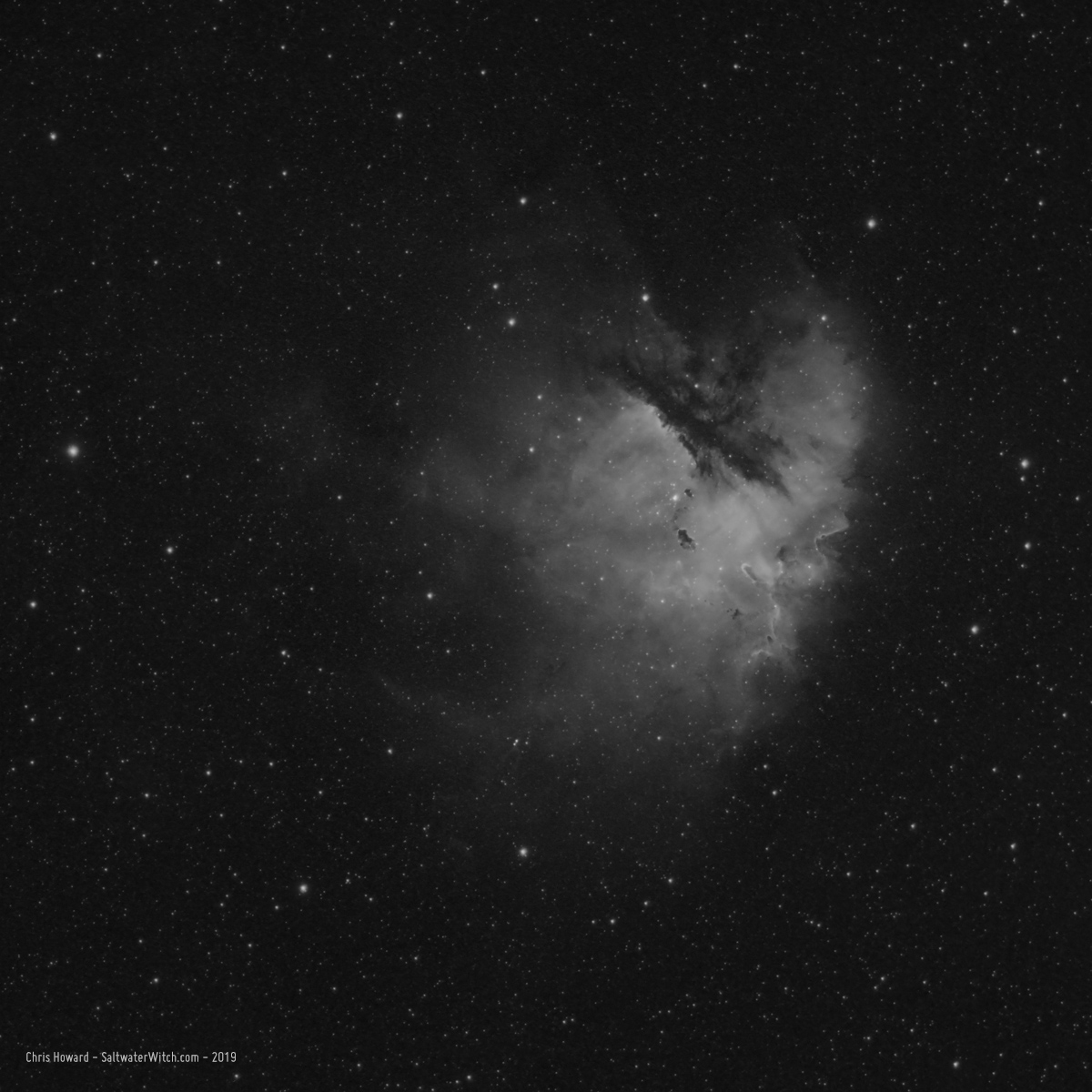
NGC 7380 star cluster surrounded by the "Wizard Nebula" in Ha:
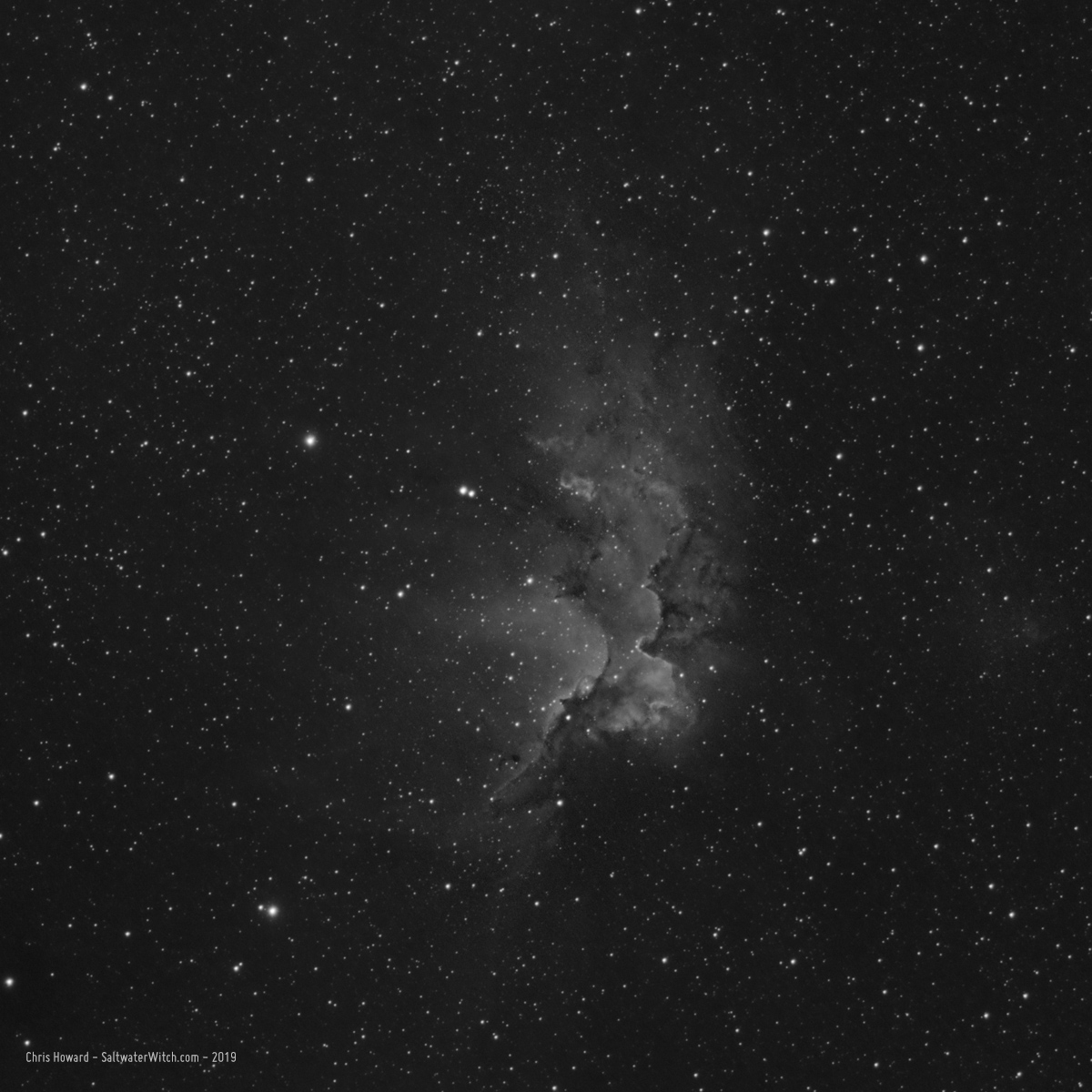
Sh2-54 Nebula and NGC 6604 open star cluster in Ha:
